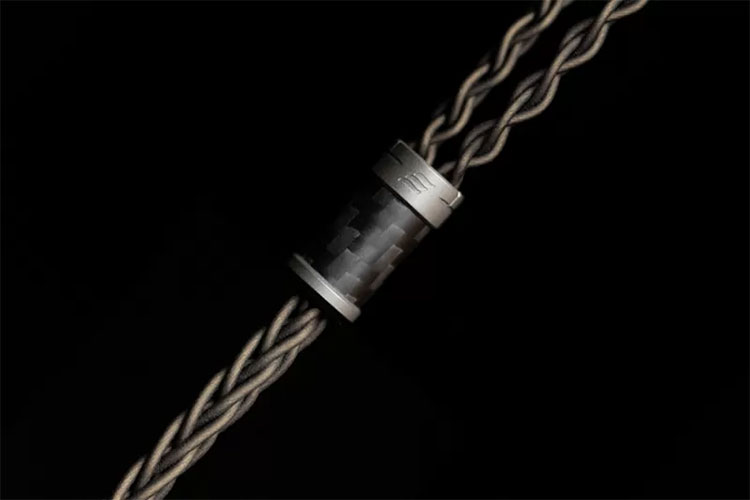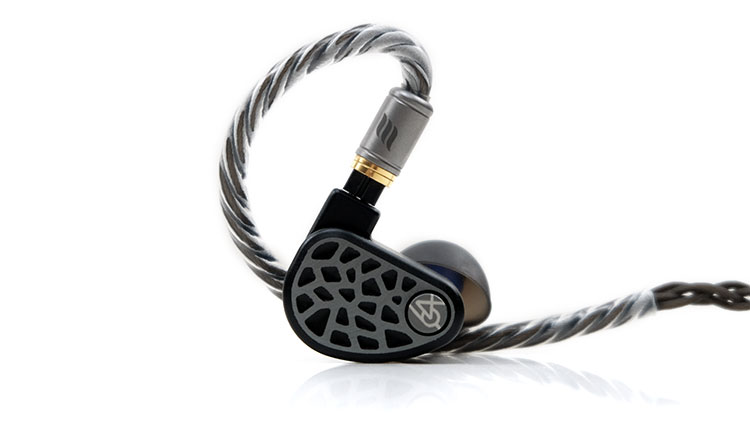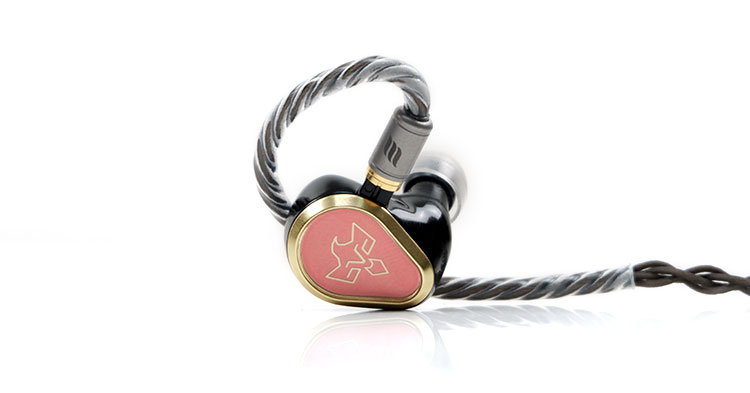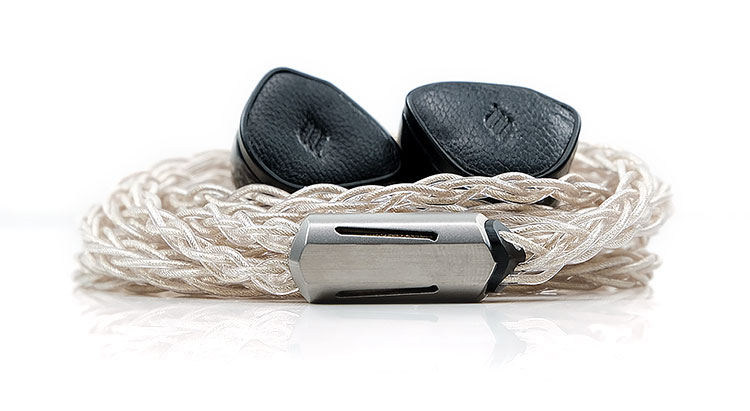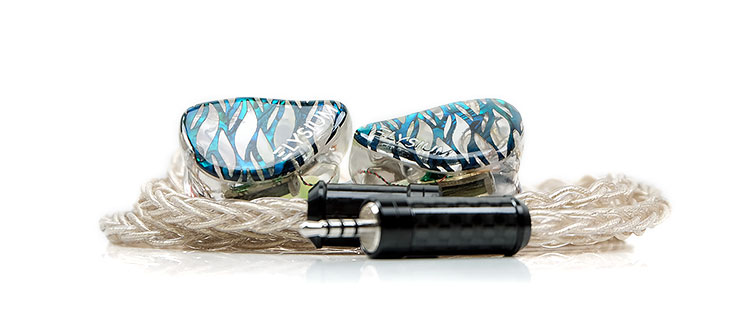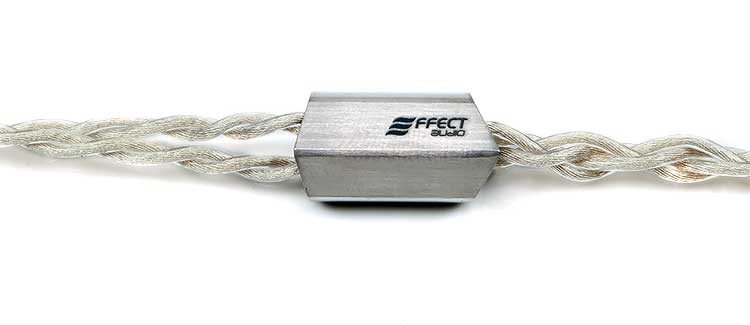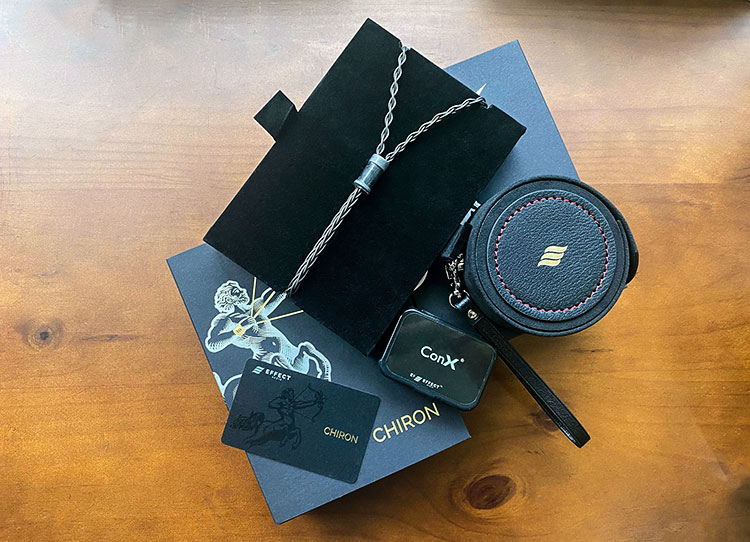Synergy
As with the Centurion, the best pairings are those monitors that have both the technical ability in terms of resolution combined with the ability to deliver an expansive soundstage. That thicker, smooth synergy from the Chiron also helps a lot if you are looking for a denser tone from monitors that have a pristine or neutral midrange.
64 Audio
For example, the A18t and the U18s mids are very complex sounding with the U18s the smoother more linear of the two, and the A18t the faster and slightly brighter tuning. Both have fairly neutral to slightly distant mids that with the Centurion tends to take second place a little in favor of the highs and excellent bass performance.
The Chiron changes it a little for me with a thicker mids timbre and a bit more warmth through the lower mids in particular. Treble energy is knocked off a little in favor of a more agreeable and smoother vocal delivery whereas the bass is dense but perhaps a little more linear in comparison to the flagship cable.
Personally, I would pick the Chiron over the Centurion for these two monitors based on my own personal listening preferences for a meaty midrange and rich vocals.
Empire Ears
Something like the Empire Ears Odin will largely depend on your preferences. For example, the Centurion does wonders for its bass and treble sparkle producing a higher contrast in its tone and a very exciting delivery overall. However, it will not really tame the upper-mids aggression of treble sparkle though, for me, it doesn’t really make it hot sounding either.
The Chiron fleshes out the mids with a bit more warmth and body and introduces a creamier tone to the vocal delivery with a little less bombastic sub-bass emphasis. It may well be the Chiron is the answer to those who have a concern about those forward Odin upper mids because they sound so much smoother and easier on the ear.
Vision Ears
For Vision Ear’s Phonix lovers this is the perfect cable for vocal emphasis and really does a wonderful job in highlighting that strength with a touch of euphony thrown in. This pairing is pure easy listening with an excellent open and wide staging quality.
Personally, I might still grab the Centurion from time to time to flesh out the treble sparkle and enhance the bass elasticity depending on the music and source.
Genres such as synthwave that have little to no voice mixing tend to favor a higher contrast sound that the Centurion brings. The Chiron is more about fleshed-out mids and creamy vocals so if that’s your preference then the Chiron might be the better match.
Select Comparisons
Comparisons were completed using a Luxury & Precision P6 Pro DAP and a mix of Vision Ear’s Phonix, Empire Ears Odin, and the 64 Audio U18s.
Effect Audio Centurion
$3999
The Centurion is Effect Audio’s current flagship cable and was launched in the middle of 2021. You can read our full review here.
Technical
There is some common synergy between these two cables with both using a 26AWG gold-plated silver-gold alloy in their wiring and both cables using a multi-sized stranded custom a septuplet (7) bundled Litz geometry. Also, neither cable uses EA’s individually enameled strand finishing which Code 51 uses.
However, whereas the Centurion’s entire 8 wires are gold-plated silver-gold alloy, the Chiron switches it up by using a gold-plated silver in a portion of its own 8-wire composition. Being the slightly cheaper of the two materials is one factor in the lower price.
All wiring within both the Centurion and the Chiron is composed of UP-OCC grade materials and wrapped in Effect Audio’s Ultra Flexi Insulation.
Design
Here, aside from the similar 8-wire girth, the two cables diverge with the Centurion’s pale gold shimmer just under a soft and smooth to-the-touch PVC jacket and the Chiron’s chocolate hue and grippy textured finish to its PVC jacket.
The aesthetical differences continue with the elaborate Centurion helmet-themed splitter compared to the lower profile dark tones of the carbon fiber and matte gunmetal vibe of the Chiron.
Form factor-wise the Chiron uses the more traditional round barrel format for both the splitter and jack barrel whereas the Centurion uses more of a hexagonal shape for the barrel and that large helmet for the splitter.
Materials are similar, however, with both cables using titanium in their barrels and connectors. However, the Centurion version does feel marginally heavier despite being shorter than the Chiron and jack barrel.
Chin cinch operation on the Centurion is striking if somewhat over-engineered with the entire front shell articulating upwards to reveal the internal wiring structure. It’s a bit more drama and pop visually but I actually prefer the stealthy Chiron splitter which is a small chunk of the barrel itself that neatly slides up and then when down just disappears so to speak. Much simpler.
Handling and comfort are the exact same as each other. Both are very quiet, with no memory retention. However, the rougher texture of the Chiron jacket feels different in the hand and a little bit grippier as a result.
Performance
First up is dynamic range, essentially the same. Initially, I felt the Centurion had a very slight edge in terms of overall resistance to loudness levels but after a while, it become more apparent that the Chiron is a little softer on the treble response compared to the energy of EA’s flagship cable.
In turn, that creates a slightly different sound with both the Phonix and the Odin. I suspect the Odin is the better match for the Chiron for vocals whereas the Centurion seems more ideal for the Phonix and the Odin bass response for my own personal preferences.
The Chiron’s more relaxed treble creates a slightly rounded note quality and a warmer richer mids timbre with both IEMs. That suits the edgier Odin’s upper mids and treble more than it does for the already dense and smooth-sounding Phonix.
The burst of energy and slightly cleaner tone of the Centurion provides a bit more bite into the Phonix performance which is what I personally go for.
The low-end response of the Odin was also fairly different sounding between these two cables. Not that the Chiron dropped the bass but rather the elasticity of the bass and the degree of separation between it and the mids range was more audible on the Centurion.
The Chiron bass also sounded more neutral in terms of impact whereas the sub-bass of the Centurion was much more pronounced.
For staging that meant my ear on the Centurion/Odin performance was pulled to the airier top end and more dynamic low-end whereas the more neutral imaging and slightly softer and warmer Chiron sound had me dead center in the smooth mids and vocal performances for most of the test tracks.
Effect Audio Horus X
$2499
The Horus X is also part of Effect Audio’s Hall Of Fame range with a price point quite close to the Chiron. This was reviewed by us in 2020 and since then it seems to have been discontinued also with the regular Horus and Horus Octa (8-wire) options available instead.
Technical
The Horus X is the other half of the Chiron equation with its 100% UP-OCC Gold-plated 5N Silver materials for the wiring. Much like the Centurion, the Horus X is a single-material cable. Both the Horus X and the Chiron are 8-wire creations though you can get the Horus in a smaller and cheaper 4-wire configuration.
The Chiron is essentially a hybrid of both taking a portion of the Centurion’s UP-OCC gold-plated silver-gold alloy and the Horus X’s UP-OCC gold-plated 5N silver and mixing them together.
Both cables have a very similar geometry in terms of using matching 26AWG gauge sizes, woven Kevlar material for its core, and the use of multi-sized stranding.
However, I believe the Horus X inner structure is not the same septuplet Litz configuration as the Chiron’s. That means no outer or inner core Litz bundles though quite what they used I am unsure.
Design
The form factor is quite similar with both the Chiron and Horus X using classic round barrel designs and that thicker and heavier 8-wire feel when handling. However, like X looks are a lot closer to the shimmer of the Centurion, perhaps with even more gold pop under its transparent smooth PVC jacket.
The Chiron’s dark chocolate tones combined with that sandblasted matte finish on the titanium barrels create a much darker lower-profile aesthetic. The X does have some nice light carbon fiber black and carbon print barrels but personally, the Chiron versions are tastier for me.
The Chiron also benefits from Effect Audio’s recent dalliances with barrel designs and how they integrate with the chin cinch. The X has a normal EA staple style adjustable cinch and to an extent so also the Chiron version.
However, there are some pros and cons. The gripper texture on the Chiron jacket makes it a bit jerkier to move up and down but in the pro corner, the way it slots into the barrel itself to disappear is much clever.
As you can expect from two 8-wire cables you will find both exert the same weight and pressure on your ear which is a bit higher than 4-wire alternatives. They do have the same memory wire coating so the comfort levels are good.
Neither have any issues with memory retention or microphonics but the textured finish to the jacket of the Chiron is rougher to the touch than the X version but it is also grippier.
Performance
Again, no difference in dynamic range between these 2 cables, and given they are both 26AWG 8-wire cables with some shared elements that should not be too surprising.
Now, in terms of timbral or FR bias using both the Odin and the U18s, I felt the Horus X sounded a little more ethereal on the highs, with more of a high-fidelity or delicate sound compared to the smoother, mid-centric, and slightly warmer Chiron.
In certain aspects, you could argue that the Horus X is the brighter of the two cables with that stronger treble overtone but not what I would call a bright cable in its own right or carrying a sting in its highs. Rather it is just a little sweeter and cleaner sounding compared to the more liquid-edged and broader notes being offered from the Chiron on both monitors.
On the low end, the Horus X sounded a little tighter with the Odin and punchier but not quite as warm or full-bodied which is something that helps a lot with the Odin lower mids.
The Chiron worked the lower mids of the Odin better for me with slightly better body and improved density right up to the vocal performance. Vocals do sound broader and more forgiving on the Chiron and airier and cleaner on the Horus X.
Staging-wise, you do get a little more high-frequency energy and brilliance with the Horus X with our tested monitors but the body and weight from the low-end to the mids are stronger with the Chiron.
Effect Audio Code 51
$2388
Launched at the tail end of 2019, Code 51 was EA’s big showpiece for most of 2020 before the Horus X and the Cleopatra stole its thunder. Sadly, it is no longer available direct from EA but you can read about it in more detail here.
Technical
Internally, Code 51 could be considered an outlier to the general house-build process EA normally uses. This was the only one that I know of that uses a larger 24AWG gauge of wire instead of their usual 26AWG that is inside the Chiron. Quite a lot of companies have since then explored even bigger gauges to good effect.
That larger gauge means that EA was able to build a 4-wire Code 51 that is quite a bit smaller than the thicker 8-wire of the Chiron and still delivers a dynamic range and performance as close as its bigger cousin.
The materials are very different also with Code 51 using an exotic mix of gold-plated silver, silver-golds alloy, and palladium-plated silver. The Chiron is somewhat simpler with a mix of gold-plated 5N silver and gold-plated silver-gold alloy. Both cables have wiring that is UP-OCC grade.
The geometry on both is relatively similar with the two cables using 7-core bundled Litz-type internal configurations though the Chiron stranding is not individually enameled whereas Code51’s stranding is not multi-sized.
Design
Code 51 is much the smaller of the two cables visually as well as being lighter due to the 4-wire structure. The binding is tight on both but with less girth on Code 51 wiring, it is the slimmer of the two designs. Both cables have the same length at 1.2m each.
For aesthetics, the Code 51 is closer to the Centurion pale gold look but with a little less shimmer underneath its soft-to-the-touch transparent PVC jacket. The Chiron looks very dark and low-profile beside the smaller cable with that rougher texture on the jacket providing a different handling experience.
Speaking of handling, the Chiron actually feels the more flexible of the two cables. Not sure if that is due to the aging process of the 2-year-old PVC jacket on this Code 51 sample or if different materials being used. I had expected the Chiron to be the stiffer of the two on account of the double wire count inside.
For comfort, no question Code 51 is going to be the lighter of the two cables on the ear but it does use a slightly firmer memory retention coating and you can just feel a slight bit more focus on that area compared to the spongier Chiron alternative. For microphonics, Code 51 has a small advantage given its smaller size with less surface area coming into contact with your ear.
I believe Code 51 was the first EA cable to use titanium for its barrels, cinch, and connectors. Chiron has continued this theme and whilst I liked the styling of Code 51’s splitter Chiron’s color-coded mix is more harmonious looking from top to bottom.
Performance
The dynamic range between these two cables is close but I have to give the edge to the Chiron with its blacker background. In fact, that is probably the lasting or most enduring technical difference between these two cables, the staging and imaging performance.
Code 51 sounds more central in its imaging with a more distinct focus on the low-end punch whereas the Chiron casts out a much wider and more holographic staging quality sounding the more complex and spacious of the two.
I will say though that Code 51’s mids and treble are a bit cleaner sounding with more energy compared to the relaxed smoother sound of the Chiron but it can’t quite make that advantage pay off with everything sounding just that bit more compressed and centralized in the presentation.
Code 51’s calling card is its low-end impact. It’s more physical, punchier, and dominating in the performance with all of our monitors, particularly the Odin. I called it explosive sounding in my original review and indeed it creates a more ‘exciting’ initial impact compared to the more even-handed roomy and smoother Chiron tone.
However, the Chiron sounds fuller to my ear throughout and especially through the mids where Code 51 thins it out a bit more and sounds the edgier of the two cables. It extends just as deep if not deeper but rather than a high-contrast overtone it delivers more warmth and richness into the instrumental timbre of our tested monitors.
Our Verdict
The Chiron almost feels like a direct response to the Centurion’s bombastic and high-contrast excitement with a more relaxed and very smooth-sounding performance when paired with our tested monitors. If mids are your fourte, complete with creamy vocals and plenty of space for them to breathe then it’s the perfect complimentary cable to the flagship’s exuberance.
And it looks so very different from almost every Effect Audio design out there right now. That chocolaty-toned textured finish, smokey finished titanium barrels, and unique chin cinch mount make it probably one of my favorite designs to date from the company.
Obviously, it’s not a cheap cable and perhaps one that is less suitable if you have a similarly priced monitor and looking for a simple upgrade to your stock cable. Like the Centurion, this is a cable to get if you have multiple high-end monitors and looking for something highly resolving with a very natural-sounding performance.
Effect Audio Chiron Specifications
- 26AWG 8Wires
- Selected Premium UP-OCC Material
- Gold Plated Silver/Gold Plated Silver Gold Alloy Hybrid
- Septuplet Core Bundle Litz
- Multi-Sized Stranding
- EA Ultra Flexi™ Insulation
- Superior PSquared/P-EA Plug with Titanium Casing
- Titanium Shelled ConX ® Interchangeable Connector




